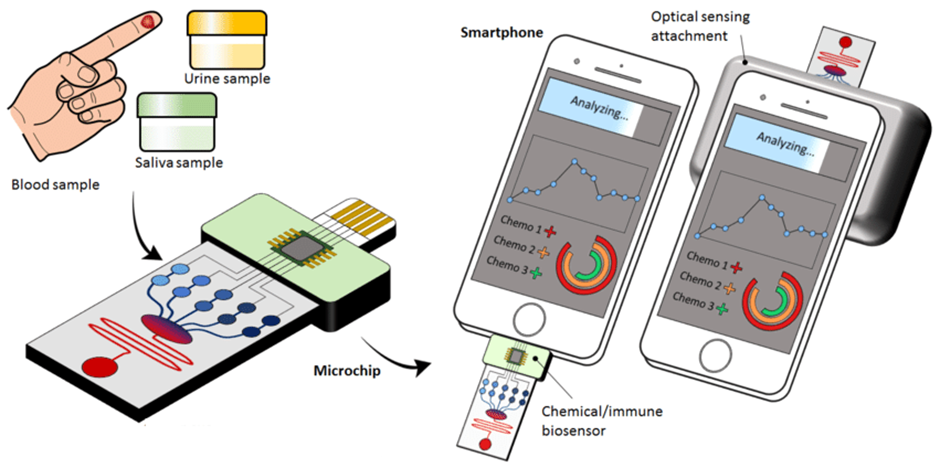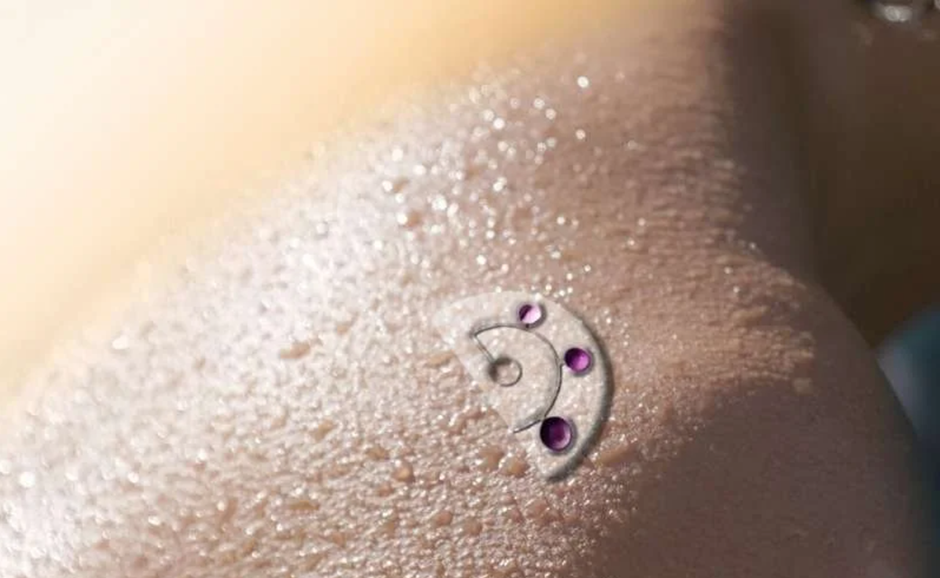Ehsan Y. Moghadam is a PhD candidate in Mechanical Engineering. Ehsan received his MSc degree in Aerospace Engineering from Ferdowsi University of Mashhad, Iran; his research was focused on numerical analysis of heat transfer and fluid flow in microfluidics. He is currently developing micro-devices to recreate the microenvironment of neurodegenerative disease conditions. These micro-devices are utilized as alternative platforms to study the cells’ activities in a more precise, controllable, and inexpensive method. His interest is microfluidics, Micro-Electro-Mechanical Systems (MEMS), fluid mechanics, and heat transfer.
Blog post
Microfluidic point-of-care diagnostic devices for global health
 Microfluidic devices integrated by biosensors and smartphone to load blood, urine or saliva samples for the detection of pancreatic cancer patients at Point-Of-Care (Samandari et al., 2018)
Microfluidic devices integrated by biosensors and smartphone to load blood, urine or saliva samples for the detection of pancreatic cancer patients at Point-Of-Care (Samandari et al., 2018)
Although there is extensive progress in the field of public health, this progress has not been equal between developing and developed countries. Over 95% of deaths in developing countries were due to the lack of timely diagnosis and treatment of major infectious diseases such as acute respiratory infections (ARIs), malaria, HIV, and tuberculosis (TB).
The World Health Organization (WHO) described fundamental requirements to develop diagnostic tools for infectious diseases summarized under the acronym ASSURED:
- affordable by those at risk of infection
- sensitive
- specific
- user-friendly (simple to perform and requiring minimal training)
- rapid and robust
- equipment-free
- delivery to those who need it
Using these characterizes can help to increase the development of more effective diagnostic methods for global healthcare.
Point-Of-Care Diagnostics
Point-of-care (POC) diagnostics provide great potential for detecting and monitoring infectious diseases, especially in remote areas where there are no large decentralized diagnostics facilities. They also need to be robust enough to withstand extremes of temperature and humidity. Therefore, it is essential that POC diagnostic technologies become rapid response, disposable, cost-effective, easy-to-use, and portable.
POC diagnostics should be capable of analyzing small volumes in bodily fluids, such as blood, saliva, and urine, and detecting a deadly chemical or microorganism with low concentration. For example, the detection of a very low concentration of dangerous bacteria in drinking water. After diagnostic testing with POC devices, the device should be disposable to protect the end-users from biohazardous samples produced.
In low-resource settings, the budgets for healthcare facilities are extremely low. To reduce POC tests' cost, parameters including minimal use of expensive reagents, inexpensive manufacturing for mass-production, quality control, and miniaturization should be considered. Moreover, there is an extreme variable in different regions and seasons. Therefore, medical diagnostic devices' clinical use should not require external water and electricity and withstand large temperature fluctuations (from 40oC to 10oC).
Microfluidic POC diagnostic devices
 Microfluidic device (https://www.precoinc.com/medical/contract-manufacturing/microfluidics), Magnified a microfluidic device left under the microscope (Lars Behrendt, https://scitechdaily.com/new-microfluidic-technology-for-the-selection-of-single-photosynthetic-cells/), (from left to right, respectively)
Microfluidic device (https://www.precoinc.com/medical/contract-manufacturing/microfluidics), Magnified a microfluidic device left under the microscope (Lars Behrendt, https://scitechdaily.com/new-microfluidic-technology-for-the-selection-of-single-photosynthetic-cells/), (from left to right, respectively)
Microfluidics is a powerful tool to impose the ideal characteristics of POC diagnostics to POC devices. Microfluidics is a technology to manipulate and control fluids in microminiaturized devices containing channels and chambers, with scale dimensions on the order of 1mm or less than 1mm. Microfluidics offers tiny and handheld devices, smaller than the palm of a hand.
Due to low fluid velocity in microfluidic devices, there is a high and accurate control on transport and mixing of molecules to separate and detect analytes. Also, microscale dimensions of these micro devices enable us to use minimal reagent and sample.
The device can be utilized to multiplex the analysis of many analytes spanning proteins and nucleic acids yielding quantitative results within 1 min. The microfluidic POC devices can integrate with mobile communications, e.g. the fifth-generation wireless communications (5G) and the Internet. It leads to remote monitoring and control of diseases, improving the doctor–patient communication. These approaches enable on-chip POC diagnosis and real-time monitoring of infectious diseases from a small volume of bodily fluids. These microdevices are highly sensitive and robust to measure species in the micro molar quantities. Given these advantages, microfluidic devices have been used for sample preparations, such as continuous blood flow fractionation, nucleic acid extraction, and purification of small molecules. Glucose testing for diabetes and home pregnancy tests are examples of successful commercial technologies that enable untrained end users to perform diagnostic testing.
 Microfluidic device monitors the health using sweat (Yingxue Zhang et al,2020)
Microfluidic device monitors the health using sweat (Yingxue Zhang et al,2020)
Future of microfluidic Point-Of-Care diagnostic devices
The recent advances in microfluidic technologies have encouraged research efforts to develop sensitive POC diagnostic devices through quantitative, proof-of-principle studies in a fast, controlled, and high throughput manner.
The challenges in deploying microfluidic diagnostic systems in the developing world will be the introduction, acceptability, sustainability, and most importantly, cost. Efforts in this field should be made so patients can test and monitor themselves in their own homes and access their personal health data without any peripherals.
About the author


